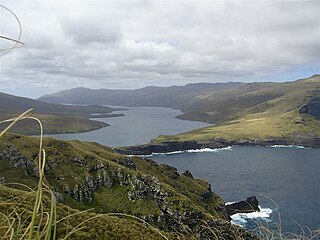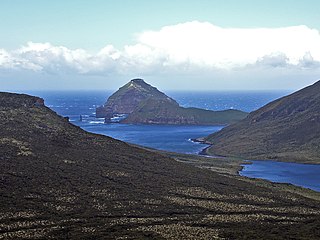
The Auckland Islands are an archipelago of New Zealand, lying 465 km (289 mi) south of the South Island. The main Auckland Island, occupying 460 km2 (180 sq mi), is surrounded by smaller Adams Island, Enderby Island, Disappointment Island, Ewing Island, Rose Island, Dundas Island, and Green Island, with a combined area of 570 km2 (220 sq mi). The islands have no permanent human inhabitants.

Auckland Island is the main island of the eponymous uninhabited archipelago in the Pacific Ocean. It is part of the New Zealand subantarctic area. It is inscribed in the UNESCO World Heritage list together with the other New Zealand Subantarctic Islands in the region.

The Auckland Island merganser, also known as the New Zealand merganser, was a typical merganser that is now extinct.

Jacquemart Island, one of the islets surrounding Campbell Island in New Zealand, lies 1 km south of Campbell Island and is the southernmost island of New Zealand.

Adams Island is the second largest island of New Zealand's Auckland Islands archipelago.

The Subantarctic snipe is a species of snipe endemic to New Zealand's subantarctic islands. The Maori call it "Tutukiwi". The nominate race C. a. aucklandica is found on the Auckland Islands. Other subspecies include C. a. meinertzhagenae from the Antipodes Islands, and C. a. perseverance from Campbell Island / Motu Ihupuku. The former subspecies from the Snares Islands has been separated as a full species, the Snares snipe, as have the extinct South Island and North Island snipes.

The austral snipes, also known as the New Zealand snipes or tutukiwi, are a genus, Coenocorypha, of tiny birds in the sandpiper family, which are now only found on New Zealand's outlying islands. There are currently three living species and six known extinct species, with the Subantarctic snipe having three subspecies, including the Campbell Island snipe discovered as recently as 1997. The genus was once distributed from Fiji, New Caledonia and Norfolk Island, across New Zealand and southwards into New Zealand's subantarctic islands, but predation by introduced species, especially rats, has drastically reduced their range.

The white-headed petrel, also known as the white-headed fulmar, is a species of seabird in the petrel family, Procellariidae. It is about 400 mm (16 in) in length.

Hakawai, also Hōkioi in the North Island, was to the New Zealand Māori people, a mythological bird that was sometimes heard but not usually seen. It is now associated with the nocturnal aerial displays made by Coenocorypha snipe.

Disappointment Island is one of seven uninhabited islands in the Auckland Islands archipelago, in New Zealand. It is 475 kilometres (295 mi) south of the country's main South Island and 8 kilometres (5 mi) from the northwest end of Auckland Island.
The Macquarie parakeet, also known as the Macquarie Island parakeet, is an extinct subspecies of the red-crowned parakeet from the subantarctic Macquarie Island, an outlying part of Tasmania, Australia, in the Southern Ocean.

Reischek's parakeet is a small green parrot confined to 21 km2 (8.1 sq mi) Antipodes Island, one of New Zealand’s subantarctic islands, which it shares with a congener, the larger Antipodes parakeet.

The Campbell snipe, also known as the Campbell Island snipe, is a rare subspecies of the Subantarctic snipe, endemic to Campbell Island, a subantarctic island south of New Zealand in the Southern Ocean. It was not formally described until January 2010. The subspecific name alludes to the name of the sealing brig Perseverance, captained by Frederick Hasselborough, that discovered Campbell Island in 1810, and which probably inadvertently introduced rats to the island when it was wrecked there in 1828.

The Snares snipe, also known as the Snares Island snipe, or tutukiwi in Māori, is a species of bird in the sandpiper family, Scolopacidae.

The South Island snipe, also known as the Stewart Island snipe or tutukiwi in Māori, is an extinct species of bird in the sandpiper family Scolopacidae that was endemic to New Zealand.

The North Island snipe, also known as the little barrier snipe or tutukiwi, is an extinct species of bird in the sandpiper family, Scolopacidae, that was endemic to New Zealand.

The Auckland snipe, also known as the Auckland Island snipe, is a small bird in the sandpiper family. It is the isolated nominate subspecies of the subantarctic snipe that is endemic to the Auckland Islands, a subantarctic island group south of New Zealand in the Southern Ocean.

Annie Meinertzhagen was a Scottish ornithologist who contributed to studies on bird migration and was a specialist regarding waders and ducks, especially their moulting patterns. She married fellow ornithologist Richard Meinertzhagen in 1921 and died from a gunshot fired under suspicious circumstances.
Colin Miskelly is a New Zealand ornithologist and museum curator.


















